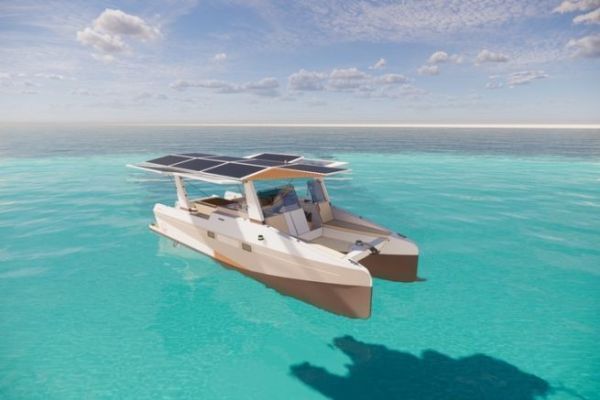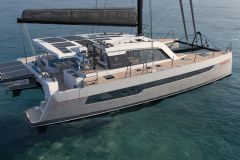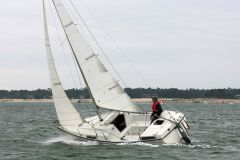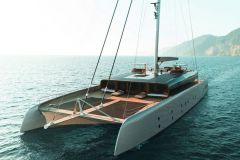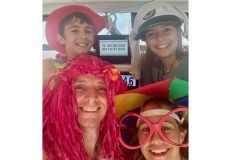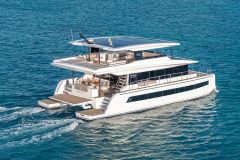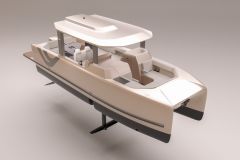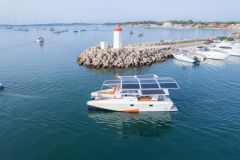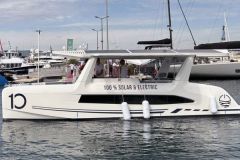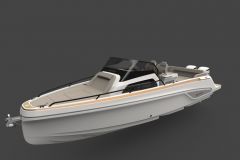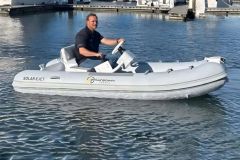Developing a 100% solar-powered catamaran
Millikan Boats is a French company founded in 2022 by Philippe Raynaud. In 2014, the founder bought the Ecolostation catamaran concept, an old catamaran onto which solar panels had been grafted. For nine years, he sailed on board without needing to make a single recharge. He then took advantage of this experience to develop his own catamaran, the M9, capable of sailing solely on solar energy, whose naval architecture was entrusted to Vincent Lebailly. Construction is carried out by the La PassagŤre shipyard in Saint-Malo. 100% made in France, the aim of the M9 is to offer the same sensations as a sailboat, with the comfort of an internal combustion engine boat.
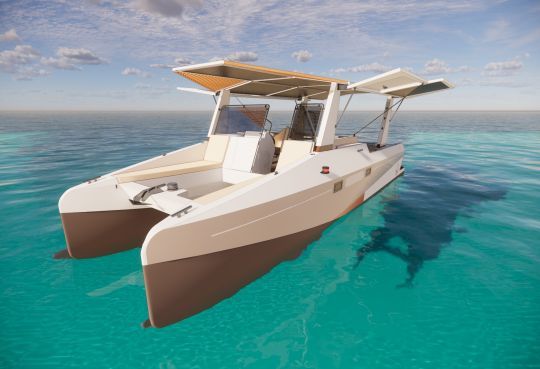
Solar panels on the roof and wings
This 9.5 m long, 3.40 m wide catamaran features photovoltaic panels on the roof and side wings. The latter unfold at anchor, and can be folded to close the cockpit completely, creating a 12m2 nacelle that is completely enclosed and sheltered from the wind. Once the wings are folded, the M9 can easily be moored in port. The width of the deployed wings then increases to 5.78 m.
The two-sided panels take advantage of the water's reverberation and, according to the site, capture 20% more energy.
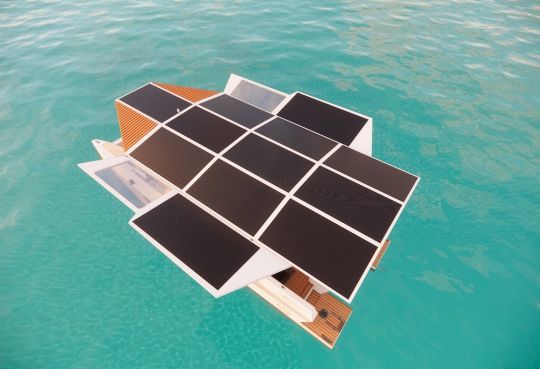
Electric propulsion from Bluenav
Electric propulsion is provided by the French company Bluenav. It consists of two 15 kW motors, connected to 10 solar panels. All in all, the M9 is powered by 30 kW of electricity from two 16.9 kWh batteries, giving a total of 34 kWh. Adrien Samoy, Sales & Marketing Project Manager, explains: "Top speed is 12 knots and cruising speed is between 6 and 9 knots. On a sunny day from 9 a.m. to 8 p.m., for example, the boat can sail indefinitely thanks to the light. At maximum speed, autonomy is around 2 to 3 hours."
A dock loader is nevertheless provided. As Adrien Samoy explains, the shipyard is considering a partnership with ports, a solution that could be deployed in the future: "In a second phase, we'll offer to supply energy to the ports in return for a fee. It won't be much, but each owner will be able to recoup a small amount."
In all, the M9 offers three speed programs:
- 6 knots on solar power alone
- 9 knots on solar power and battery reserve
- 12 nodes on battery power alone.
Adrien Samoy explains: "The M9's program is designed for weekend outings, between sailing, anchorages and ports. While the boat is stationary, the batteries recharge. It takes about 3 to 4 hours of sunshine to fully recharge the batteries."
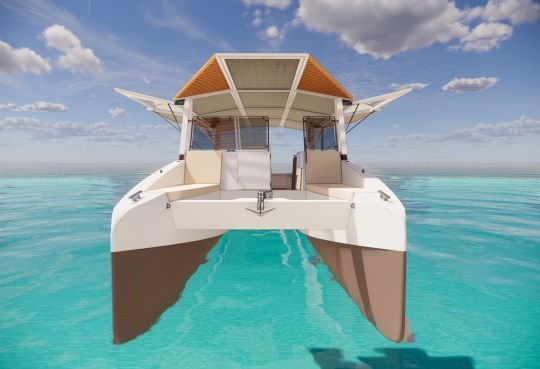
A virtual anchor system for anchoring without damaging the seabed
To facilitate anchoring and preserve the seabed, the M9 is equipped with a virtual anchor system, also supplied by BlueNav. The project manager explains: "The anchor works from a GPS position. The motors rotate 270į to maintain position, all without consuming too much energy."
The anchor system, like the electric propulsion system, is controlled via an IMH interface which allows you to check the status of the motors, batteries, their temperature, range...
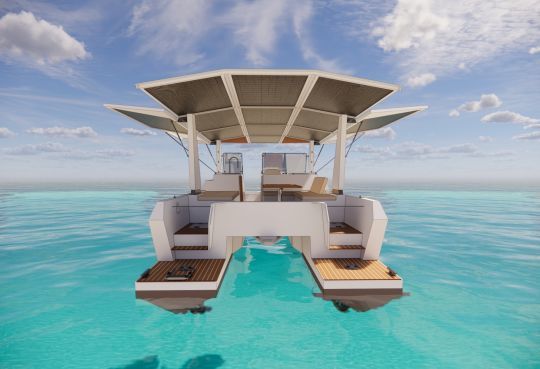
Sleeps 6 in three double beds
Millikan Boats chose a lightweight hull form and materials for the design. The boat is built in plywood for a final weight of 2.4 to 2.5 tons. Inside, the port and starboard hulls house a cabin with a 200x110 cm bed and a shower room with WC and washbasin. In the cockpit, once the fenders are closed, the saloon transforms into a 200x140 cm double berth. In all, the M9 offers up to 6 berths. The wings are folded with a tip and a cleat, but it will be possible to opt for operation on an electric jack. Access to the front trampoline is via a central passage in the windshield, and offers access to two side meridian seats containing storage compartments.
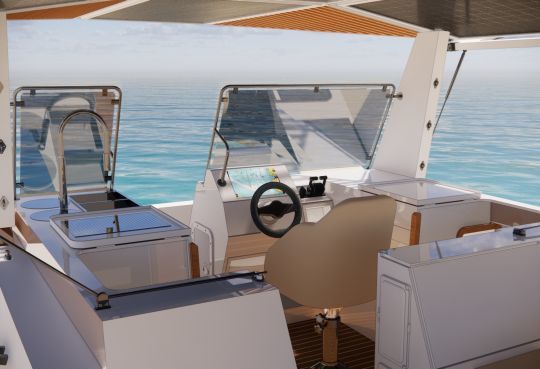
The cockpit features a 2-metre table and L-shaped sofa. The helm station on the starboard bow is equipped with a Raymarine screen. The boat will be equipped with a 4G card to take advantage of the Wifi network and carry out updates in real time. An application will also enable you to control your boat from your smartphone. The galley, located next to the helm station, features a 120 L refrigerator and sink, fed by a 50 L water tank. Finally, at the stern, two attractive 1m2 bathing platforms provide access to the water. The engines are concealed here, slightly recessed.
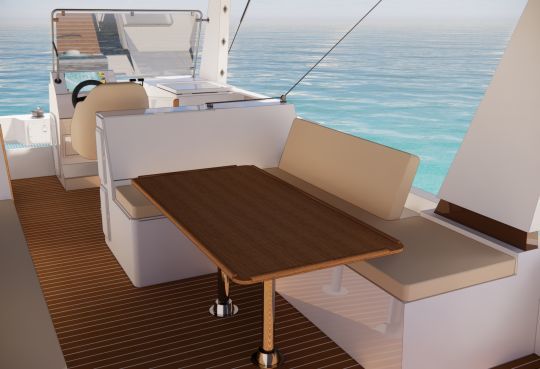
Prototype testing in summer 2024
The demonstrator will be launched in the summer of 2024, and the first models marketed thereafter. Prices start at ?250,000 incl. VAT.

 /
/ 